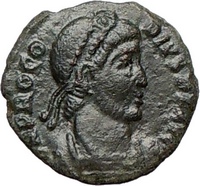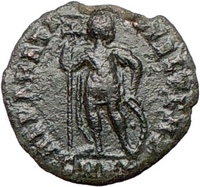Procopius Roman Emperor Usurper 363-366 A.D.
Biography of Roman Emperor & Certified Authentic Ancient Roman Coins
Buy certified ancient coins with Procopius Roman Emperor
Every item purchased here comes with a beautiuful
custom-made certificate of authenticity, complete with professional
description, research, professional photograph and
historical synopsis, a $50-$100 value, absolutely free, signed by
world-renowned ancient coin expert, Ilya Zlobin.
Watch the vide below for more in-deph details


Example of Authentic Ancient
Coin of:
Procopius - Roman Usurper: 365-366 A.D.
Bronze AE3 Heraclea mint: 365-366 A.D.
Reference: Unlisted
DNPROCOPIVSPFAVG - Diademed, cuirassed bust right.
REPARATIOFELTEMP Exe: SMHΓ - Procopius standing facing, head right,
holding labarum
in right hand, left resting on shield set on the ground.
The Chi Rho is one of the earliest
christograms used by Christians. It is
formed by superimposing the first two letters in the Greek spelling of
the word
Christ (
Greek : "Χριστός" ), chi = ch and rho =
r, in such a way to produce the
monogram ☧. The Chi-Rho
symbol was also used by pagan Greek scribes to mark, in the margin, a
particularly valuable or relevant passage; the combined letters Chi and Rho standing for
chrēston, meaning "good." Although not technically a cross, the Chi
Rho invokes the crucifixion of Jesus as well as symbolizing his status
as the Christ. There is early evidence of the Chi Rho symbol on
Christian Rings of the third century.
relevant passage; the combined letters Chi and Rho standing for
chrēston, meaning "good." Although not technically a cross, the Chi
Rho invokes the crucifixion of Jesus as well as symbolizing his status
as the Christ. There is early evidence of the Chi Rho symbol on
Christian Rings of the third century.
The labarum (Greek:
λάβαρον) was a
vexillum (military standard) that
displayed the "Chi-Rho"
symbol, formed from the first two
Greek letters of the word "Christ"
(Greek:
ΧΡΙΣΤΟΣ, or Χριστός) Chi (χ)
and Rho (ρ).
It was first used by the
Roman emperor
Constantine I. Since the vexillum
consisted of a flag suspended from the crossbar of a cross, it was
ideally suited to symbolize
crucifixion. The Chi-Rho symbol was
also used by Greek scribes to mark, in the margin, a particularly
valuable or relevant passage; the combined letters Chi and Rho standing
for chrēston, meaning "good."
Procopius (326 - May 27, 366), was a Roman
usurper against Valentinian I, and member of the Constantinian dynasty.
According to Ammianus Marcellinus, Procopius was a native of Cilicia. On
his mother's side, Procopius was cousin of Emperor Julian.
Procopius took part in the emperor Julian's campaign against the Persian
Empire in 363. He was entrusted with leading 30,000 men towards Armenia,
joining King Arsaces, and later return to Julian camp. At the time of
Julian's death, there were rumors that he had intended Procopius to be
his successor, but when Jovian was elected emperor by the Roman army,
Procopius went into hiding to preserve his life. The ancient historians
differ on the exact details of Procopius' life in hiding, but agree that
he returned to public knowledge at Chalcedon before the house of the
senator Strategius suffering from starvation and ignorant of current
affairs.
By that time, Jovian was dead, and Valentinian I shared the purple with
his brother Valens. Procopius immediately moved to declare himself
emperor. He bribed two legions that were resting at Constantinople to
support his efforts, and took control of the imperial city. Shortly
after this he proclaimed himself Emperor on September 28, 365, and
quickly took control of the provinces of Thrace, and later Bithynia.
Valens was left with the task of dealing with this rebel, and over the
next months struggled with both cities and units that wavered in their
allegiance. Eventually their armies met at the Battle of Thyatira, and
Procopius' forces were defeated. He fled the battlefield, but was
betrayed to Valens by two of his remaining followers. Valens had all
three executed May 27, 366.
|